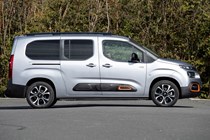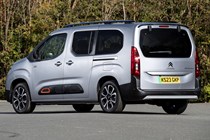
Citroën e-Berlingo long-term test
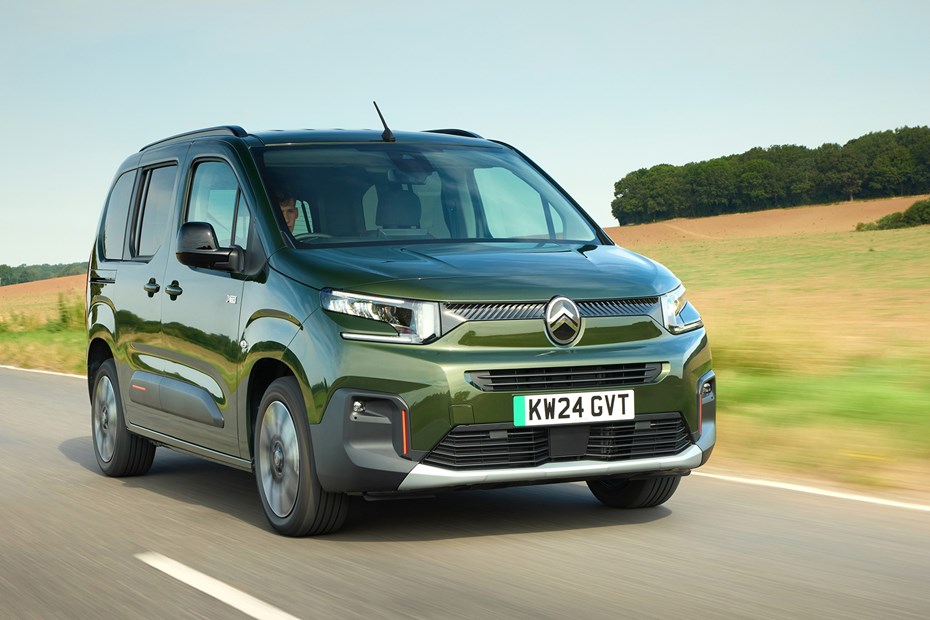
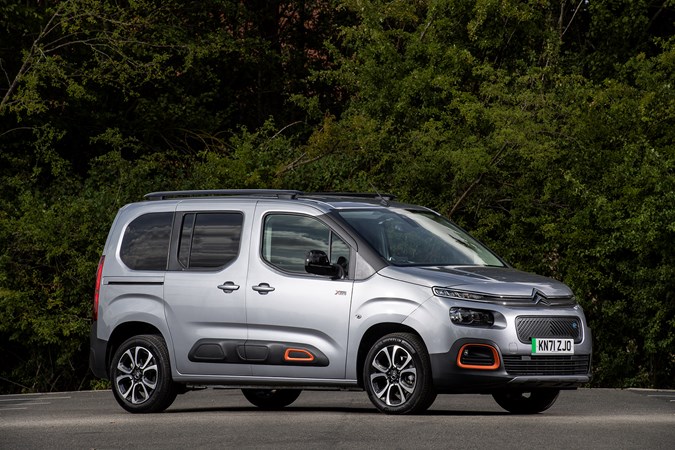
Compact, practical and eco-friendly. The Citroen Berlingo has always appealed to rational, sensible people who put substance ahead of image, and the e-Berlingo completes the anti-consumerism counterculture vibe by reducing dependence on oil to a distant, remote concept. The question is, is it still useful?
Reports by Richard Kilpatrick.
Citroen’s popular MPV, the Berlingo, is no more*. Like its Peugeot Rifter and Vauxhall Combo Life equivalents, the fuel-burning engines have been banished, and the only version you can buy now is the electric e-Berlingo. It’s been out for a while though, and drivers keen to convert to electric have been waiting for used EVs to start showing up – so Parkers is looking at an approved-used e-Berlingo Flair XTR, similar to examples you will find through Spoticar or our own electric cars for sale search.
*the van remains on sale with petrol and diesel options as well as electric power
Keep scrolling to read the updates, or use the links below to find out what it’s like to live with for costs, practicality, technology and lifestyle.
- > Update 1: Intro below
- > Update 2: Costs and charging
- > Update 3: Practicality and family-friendliness
- > Update 4: Technology and gadgets
- > Update 5: Who is the Citroen e-Berlingo for?
- > Update 6: subscribe to the Parkers newsletter for the latest news and updates
Update 1: Welcome to the approved-used Citroen e-Berlingo
With so few used electric cars on the market and delivery delays due to demand, we take a look at a typical ex-demo example you would find through Spoticar
When you think about electric cars, you probably go one of two ways. Slow, small, short range city cars like Smart EQs or those old G-Wiz things. Or you imagine a Tesla or maybe Porsche, expensive, flash and fast. You probably haven’t noticed the existence of electric Citroen Berlingos, because they look very much like normal Berlingos.
However, as a former Parkers family car of the year winner, we know the Berlingo meets the needs of most users. An electric model would certainly slash running costs, but what about purchase?
Our approved-used example is a typical ex-demo car you might find from dealer stock. It’s traditionally the place to find the biggest and best savings, but these are strange times. This 5,000 mile e-Berlingo XTR Flair would cost about £35,000 new (there’s no plug-in grant for cars now; vans still benefit), and on Spoticar, the cheapest equivalent car is £29,999.
There’s also one with 10,000 miles for £35,999. So, either the e-Berlingo is a zero-depreciation vehicle, or the best advice we can give at the time of writing is ‘wait’. For context, the cheapest electric car on Spoticar is the Vauxhall Corsa-e, for £25,000. It has the same battery and motor and much less space.
There is an exception to the plug-in grant; if you need a wheelchair accessible vehicle the e-Berlingo qualifies, but there are a limited number of grants available. An approved-used car and appropriate support from Access to Work or Motability may provide a solution if grants and new vehicles are unavailable.
How well does the e-Berlingo age?
This may as well be a new car. The bodywork is excellent, there’s no dirt, the engine bay is spotless. In recent years cars gave generally been so well made that they don’t show much wear for the first three years and 60,000 miles anyway, but with the added bonus of emissions (and oil) free electric power this will probably look the same after a wash in five years as it does now.
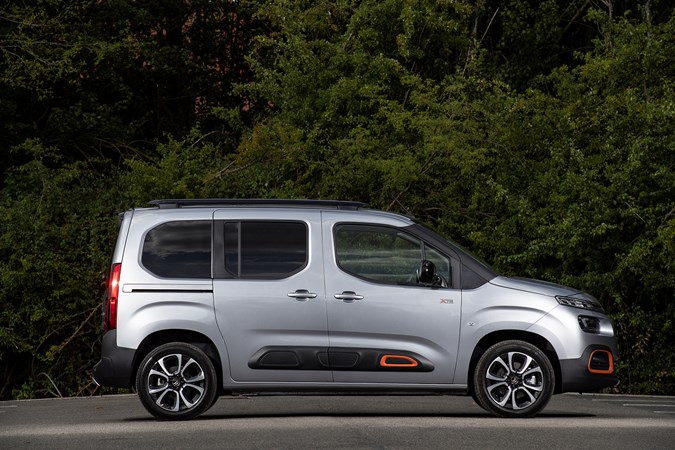
Spoticar perform 121 checks on their cars – of all brands – and provide a 30-day return if the car has faults, and a 12 to 24 month warranty. Curiously the used e-Berlingos are marketed with 12 months, but should have plenty of manufacturer warranty left. Two mild kerb marks on the wheels were pointed out on delivery, these would normally be rectified for a customer.
The infotainment system is clear of any previous user’s data, but the maps and software have not been updated. That means downloading an app, putting 32GB of files onto a USB memory card, and driving about; what you can’t do is plug the memory stick in and run the update while the car is charging. If you’re buying one, I would ask the dealer to update the maps and software before collection; it’s an easy process but it takes a couple of hours.
Quick stats – e-Berlingo
For full details, read the full review, but in a nutshell the e-Berlingo has a 50kWh battery and a 136hp motor, can seat five including three Isofix seats in the back, and will do about 170 miles on a charge in the right conditions. It’s quite quick, and can reach 62mph in 9 seconds, with top speed capped at 84mph. Advanced features include the MyCitroen app which can display charge, log journeys and control air conditioning from your phone, and a head up display – but otherwise this is a £35,000 car that you have to twist a key in a lock to start, have to open your own tailgate on, and isn’t trimmed in rich Nappa leather.
Charging is by 7kW Type 2 cable (11kWh is an option, but few have it) or 100kW; a 13A three-pin charger is an accessory (if you charge on a normal socket it’ll take around 24 hours, though topping it up for short trips is feasible).
First impressions of the e-Berlingo
It’s easy to get comfortable on the refreshingly colourful fabric-trimmed seats, though at first the dashboard and windscreen feel distant and inefficiently-sized. If it weren’t for the green trim and picnic-basket strap on the glovebox it would feel very basic in here.
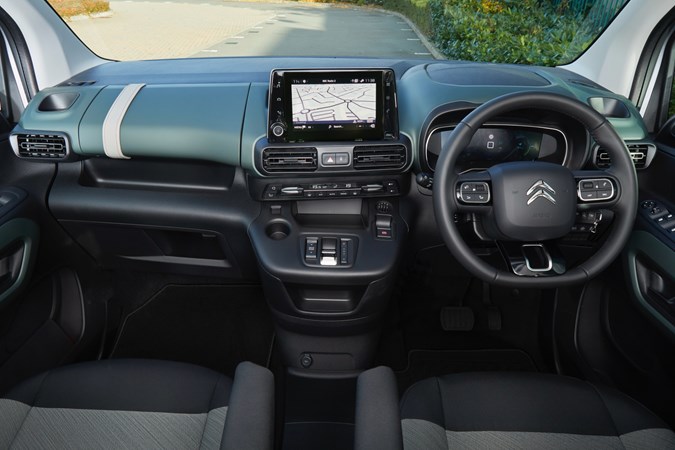
It’s silent, any EV noises it makes aren’t really audible in the cabin, and the ride and handling reflect a heavy car with a low centre of gravity. It’s secure, but thuds over imperfections. I wouldn’t choose one without the panoramic roof and roof storage options, personally.
The e-Berlingo’s massive tailgate and lack of storage compartments means the opening back window and roof-mounted box would be a big improvement, even if the rest of the option weren’t fitted.
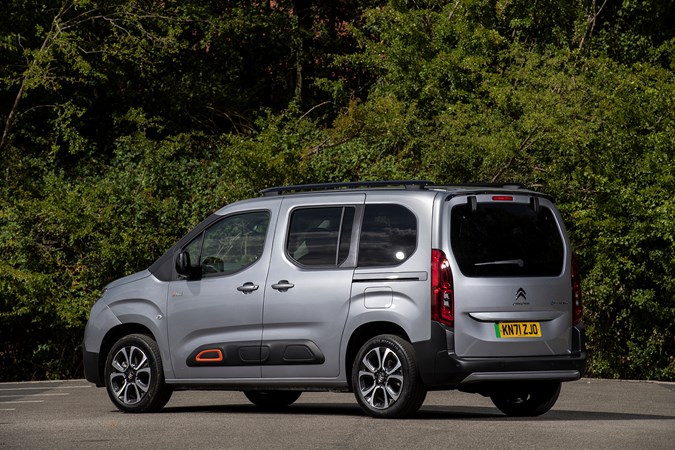
My first drive is to Nottingham, 51 miles away with a little bit of motorway. Starting with 164 miles range, my driving is cautious at first but keeping up with the rest of the traffic, and when there’s nowhere to park the electric motor feels particularly inoffensive to switch on and shuffle the car to a different space.
For the return journey I’ve got plenty of remaining range, so I make more use of the modes. Eco for HGV-heavy A52 50mph, but power on a hilly A-road, even overtaking a van and trailer where the Berlingo proved more eager than I expected. That low speed limiter implies low speeds, but it feels like it has the same ability as other 50kWh + 136hp vehicles from Stellantis and just cuts off before the motor is struggling.
Home, and it has 64 miles remaining. It’s summer so conditions for the battery are perfect, but the climate control was on and I didn’t drive for economy – the range prediction was spot on, which is reassuring.
Looking at it on the drive, I think it’s quite attractive, too. The styling is distinctive, and though I’ll never ‘like’ Citroen’s bulbous front end theme, overall it’s a purposeful, rugged-looking van. Details such as the orange highlights and roof bars help it feel more of a lifestyle vehicle and less commercial.
It could be a hard-working family car, or a lifestyle toy for leisure, or an entrepreneur’s compromise between van and car. It leaves people guessing as to the type of person driving it. Truth is, it costs more than an entry-level Evoque. No matter who is driving an e-Berlingo, they’re going to need a stronger justification than just saving money on fuel, let alone the planet.
Update 2: Summer range and cost-of-living
It’s not the Citroen’s fault, but electric cars are getting expensive…
As mentioned in the first update, electric cars are not cheap. New cars are not cheap, right now, and for more experienced, older drivers it’s a shock to the system finding that the assumption that a low deposit and £200 to £300 per month will get a nice, even ‘a bit fancy’ new car has evaporated. It’s a double-whammy; the oversupply that meant huge fleet discounts and unrealistic finance compared with list price has become supply constraints meets an underperforming currency, increased costs and inflation.
And last year, when the first signs of the inflation part started to creep in, we could argue that the lower costs of running an electric car offset the higher price for the technology. That is getting to be a harder argument as time passes, people’s fixed-rate contracts end, and the energy price cap becomes less of a goalpost and more of a fake hare whizzing around a greyhound track.
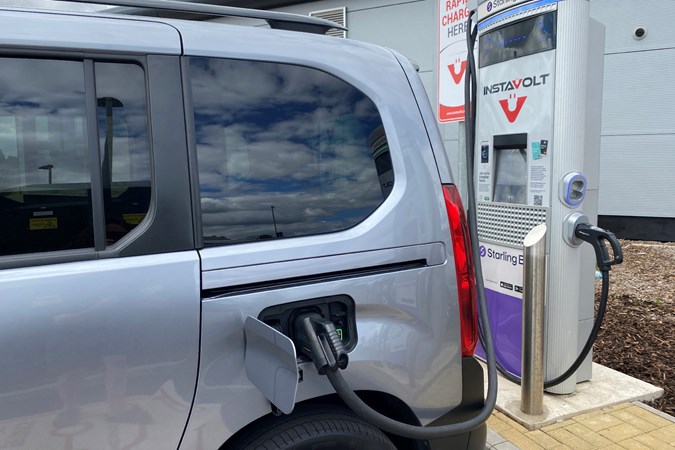
As I write this update, Osprey has announced rates of £1 per kWh at its chargers, my local InstaVolt has gone up to 66p. When not charging at home the e-Berlingo now costs as much to run as a 30-40mpg petrol car as fuel price fluctuations seem almost daily at the moment.
In fact, if I had to use Osprey, it would cost me more to drive the e-Berlingo, than to take one of my mid-2000s petrol cars. Well, maybe not the RX-8. They do about 35mpg, typically. That, compared with £1 to do 3.4 miles, is far too close for comfort when making the eco-is-affordable argument.
Supply and demand strikes again
Electric charging is still a problem, even if you do argue that you might spend ages in a big motorway services, the queues for those chargers mean that ‘no time lost’ combination of charge & dinner overlapping has gone.
Now you have to wait AND then still want your food. But it’s a problem that is more or less severe depending on your lifestyle, and I’m just the wrong combination of location, habits and routines. For local errands and commuting to the office the e-Berlingo is rather lovely.
As an example, I had two computer-related errands over a weekend – collect some from Cambridge, deliver some to near Watford. I’d planned to do both in the Citroen, but a planned top up in town while shopping in Boston was scuppered – the advertised and shown on Zap-Map car park chargers were all faulty. The collection was managed well enough, but the car was almost empty by the time I got back, and I had to leave in the morning.
With just eight hours between trips, charging on the home charger would struggle to get enough range to reach another fast charger en-route. A six-hour round trip begins to look like a nine-hour one, as I’ll need to top up on the way back too, and there’s no guarantee I’ll find an available fast charger right away.
In the end I took my PT Cruiser for the second errand, and in the process discovered its trip computer is still in US gallons; a displayed 30mpg is actually 36mpg according to Fuelly and my own calculator.
So on the worst public chargers the e-Berlingo would have cost more for the same distance than a notoriously bloated, inefficient and polluting 2.4-litre American car.
Houston, we have a problem.
Update 3: The ultimate family leisure vehicle
I need one vehicle capable of transporting my family and mountain bike – is this it? Asks Adam Binnie
The Citroen Berlingo is to mountain bikers what the VW Transporter is to surfers. Don’t ask me why this is, but if I had to speculate, I would suggest it’s the combination of a bike-sized boot and accessible used values that make it such a tempting second vehicle for your hobby.
Sound extravagant? Bear in mind a new mid-range MTB will set you back at least £3,000, and you can easily spend five figures on an all-singing enduro e-bike. In context, £1,500 for a dedicated vehicle to transport it in doesn’t sound too bad.
Either way, when Richard said his e-Berlingo was going spare for a week I jumped at the chance to be King of the Bike Park – something I’ve experienced only once previously when I installed my not-even-nearly £3,000 Santa Cruz into the loadbay of a Ford Ranger Raptor.

To make things even more interesting, we had a packed family weekend planned and that meant the e-Berlingo wasn’t going to have an easy second-vehicle life. No sitting around the corner waiting to be loaded up with a bike – it had 48 hours of daily-driver abuse to look forward to.
Things kicked off with a birthday shopping trip for my wife, lunch out and then an afternoon swim. All of these places were in opposite directions from my house but in theory all within the 50kWh battery’s 170-mile reach. I don’t really get range anxiety – I’m lucky to get 100 miles from my motorbike tank, so anything more feels like a luxury.
Because I can focus my enjoyment of driving (or riding) onto two wheels these days, I can happily get excited about having three individual chairs in the second row, each with Isofix points. Fold-out picnic tables apparently have the same effect on my kids, although they’re not braced underneath, so will collapse if you lean too hard on them while playing a Nintendo Switch. Apparently.
Slide into my dreams
Sliding doors on either side of the car made child seat fitment an absolute dream, although the design of the headrests necessitates their removal, so they rattle around in the footwells. I also had to do this in order to collapse the driver-side rear seat, but I suspect that’s because my driving position is so far back.
The doors also require quite a bit of heft to open and close – more than either of my kids can muster, so I have to do it for them, which is annoying. But there’s a slightly larger issue in the location of the charging flap that I haven’t encountered before in an EV with normal doors.
Bear with me – but you can’t open the kerbside door when the car’s on charge, because the cable is sticking out of the side, and the door would bang into it. There’s actually a catch mechanism that stops you from opening it even a small amount, which in some ways is quite clever because it avoids flap-damage, but is also quite inconvenient. (This was literally the first thing I tried when I saw where the flap was – Richard).

When you pull up to a charger with a car full of people, they have two options – the first is to get out and then wait for you to faff about with charging apps and cables. I’ll let you into a secret – a four- and eight-year-old are not going to wait patiently while you do this, they’re going to run in opposite directions towards the most hazardous thing they can find.
The second is to wait in the car and then get out the driver’s side. Chances are you’ll be in a car park but you might be parking on the road, and then they have to exit into traffic. Even if you are in a car park, if you’ve drilled it into your kids that they have to get out the kerbside door as I have, you’re now being inconsistent, and if you’re wrong about the car door, in their eyes you’re equally wrong about Haribo eggs being an inappropriate breakfast item. In fairness, I’m not the parent that disputes this.
Anyway, I suspect this is a right-hand drive conversion issue but it is annoying, and the point of a big family MPV like this is to be as least annoying as possible. Actually, it should be a vacuum that actively absorbs external irritants like silica gel. So that’s a trick missed.
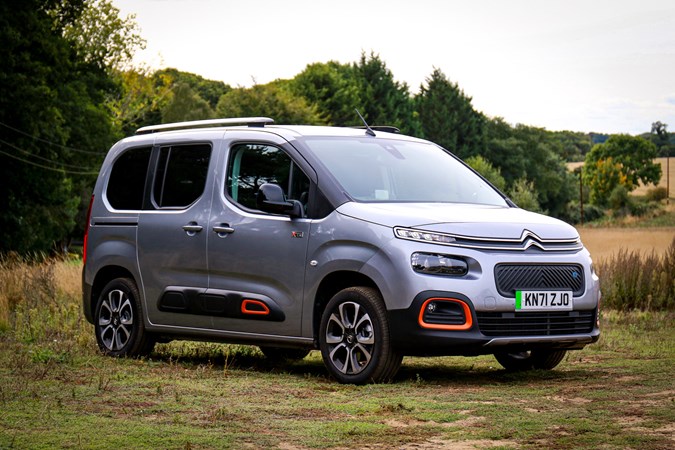
The other issue is the brake pedal modulation – you press it a little bit and not much happens, then you press it a bit more and a lot of braking occurs. This makes it somewhat difficult to drive smoothly, particularly if you have it in the regenerative “B” mode. A regen fierce enough to avoid using the brake entirely (called one-pedal driving) would solve this problem, I think.
Other than those small gripes the e-Berlingo is superb – electric cars are brilliant for ferrying kids about because they’re so wafty and quiet. The 136hp on offer is more than enough, frankly, and a combination of super-light steering and massive windows makes easy work of low-speed manoeuvres, despite the car’s size.
When we returned from spending a small fortune in Decathlon and found a car parked 1/8th of an inch from the rear bumper, I did at least get to test the opening glass section of the tailgate to post our purchases through. A shame really, because I was looking forward to testing whether I could open the bootlid through the other car’s grille. The boot door is enormous (but so’s the boot) and has nearly taken my head off a few times, so having a smaller hatch means you don’t need to leave a six-foot gap behind you whenever you stop.
Where’s all the kit?
After swimming I yearned for the heated seats of my car and was reminded of the slight disparity between this e-Berlingo’s price tag and its spec. This one doesn’t have the modular roof or any covered storage under your arm (you do get an armrest though) and while there’s an effective lane-keep aid, the cruise control is not adaptive. I know the budget goes on the drivetrain in this model but still, it feels a bit sparse in places.
On day two the boy and I went karting (well he went, I watched) before I was finally free to load my bike into the boot and go for a ride. I reckon I’ve put my bike in a hundred different cars by now, and attached it to the roof or a tow bar rack of a similar number, so I’m something of an authority on this very niche subject.
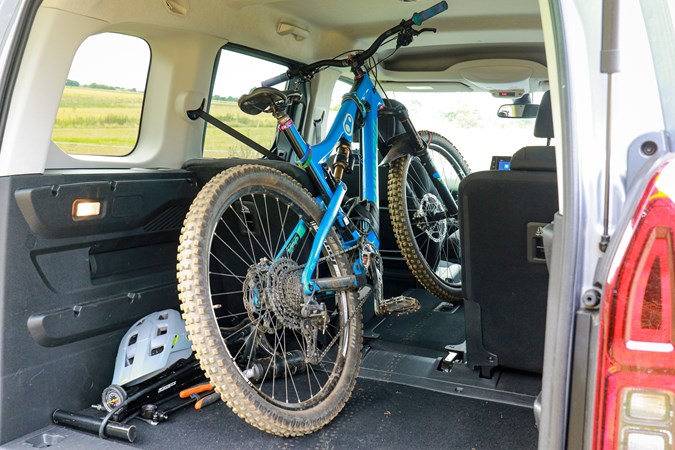
Of all the cars I’ve tested (not counting vans and pickups), this is by far the best, and not just because my bike went in with both wheels on and stood up. Why do those things matter? Because taking off a muddy front tyre after a ride is a pain, frankly, and there’s never anywhere good to put it in the back of a car where it doesn’t bounce around and scratch your frame. You can buy a bag for it, but really, come on. Do you want to do that?
The same goes for keeping the bike upright – a dirty bike lying in a car boot basically sandpapers its own paint off while you drive home. You can of course wash it before it goes in if you have a cordless pressure washer, but then it’s wet, and that makes a different mess.
I tried loading it in rear-wheel first, but the tall front end didn’t fit, so my bars rubbed on the ceiling. I suspect the modular roof would rule this out entirely. Span around and installed front-wheel first, it rode into the car with no drama. I had to drop the middle seat but because they’re individual, I could do so without removing my child seats. Although I did out of habit, which I now regret.
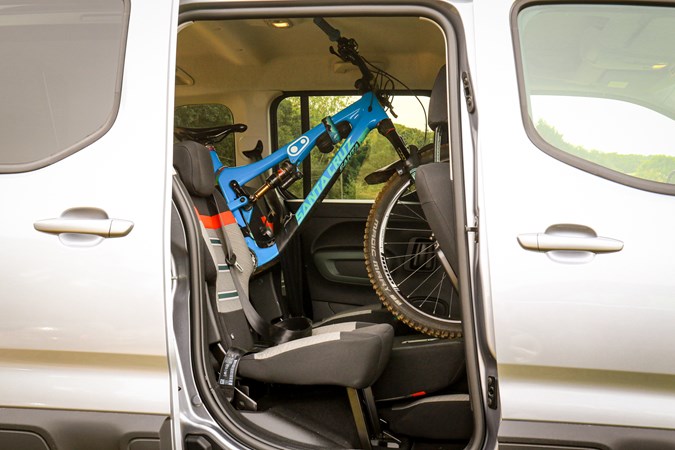
I held it in place with a seatbelt wrapped round the frame and a small tie-down strap around the front wheel and passenger headrest. The bike didn’t move until we arrived and parked up despite some spirited driving. There’s even a cubby under the glovebox that is perfectly sized for my camera, so I could hide that under a t-shirt while I went to ride.
Verdict
I can see what all the fuss is about now – the e-Berlingo is big enough to carry a bike, like a van, but drives like a car and comes with all the associated comforts. Like carpets. I can also lock it inside and then buy lunch in town or stop at the supermarket on the way home. I wouldn’t dare do either with my bike locked on the roof or the tow bar – it’s just too risky.
Obviously, it’s far too expensive to consider purchasing one for just this purpose, but the e-Berlingo is a very convincing family car at the same time. The range would be an issue for us when visiting far away relatives and those smaller annoyances I identified earlier aside, it’s really hard to find fault with.
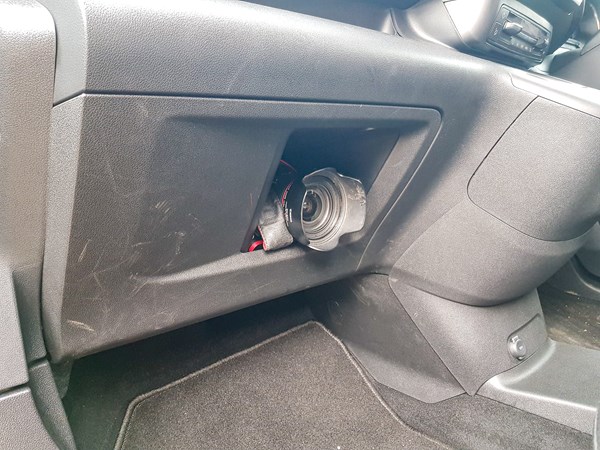
But you wouldn’t need a second vehicle really – as a family car and leisure vehicle in one this ticks a lot of boxes, without requiring an enormous commercial vehicle footprint, or the associated lower speed limits. As soon as my children’s arms are strong enough to open the doors, I think I’ll buy one.
Update 4: Updates and apps
Logging off loses logs, but at least it feels like the car’s getting attention
There are two schools of thought when it comes to updating software. There are those who hang on with determination to what they have until forced to let go, and there are people like me, who excitedly refresh every bit of firmware, software and downloadable content going.
As mentioned in the Peugeot 3008 Hybrid4 updates, Stellantis’ French cars have come a long way when it comes to the on-board tech. No more trips to the dealer for a grumpy and often expensive refresh, you download an app to your computer and it writes an update file with software and maps.
You’ll need a 32GB USB stick; yes, I’ve lost it. Again. Another £20 on Amazon.
Once downloaded, you need to switch the ignition on and let it refresh. It takes quite a long time, between twenty minutes and two hours, and it’s recommended you do it while driving but oddly enough there aren’t many times you drive an e-Berlingo for two hours straight. So I just switched the engine on and left it to it, at least it’s not polluting.
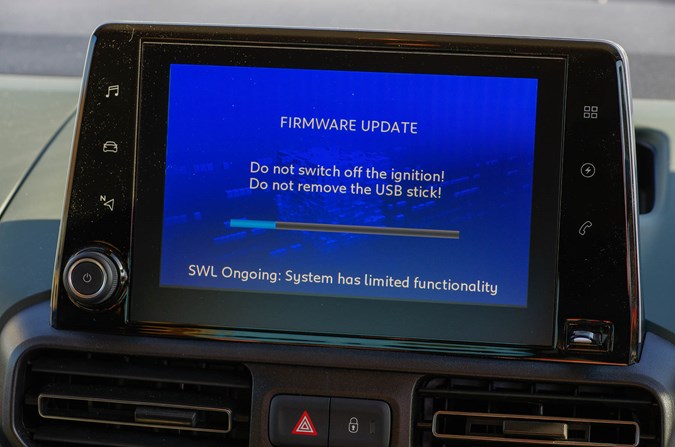
This does seem a little disjointed when you can connect the car to mains power, so the reason you have to leave it running – ensuring the radio doesn’t switch off to protect the battery – shouldn’t be an issue. But you can’t have ignition on while it’s charging. Other firms, such as Ford, are still ahead of the game with seamless background OTA (over the air) updates.
But that’s not the frustrating part – what’s annoying is the app. It still has that irksome ‘allow to use bluetooth’ warning on iPhones every single time, and then when iOS updated to version 16 it logged me out of the app (fine) and lost my mileage and distance records (very much not fine). These apps and smartphone tools are an increasingly important part of the car experience; even the owner’s handbook and service records are accessed this way now. They need to be much better.
What can you do with the Citroen e-Berlingo’s app?
Unlike some apps which allow you do control windows and door locks, the connected services available on the Berlingo (and most Stellantis French cars I’ve tried) are fairly limited. You can schedule or start pre-heating, view mileage and available charge, and charging status, but if you’re worried you left a window open or forgot to lock it, start walking back.
The distance logs (until they were lost, anyway) have improved a lot compared to earlier in the year and the e-Berlingo didn’t miss a single 1-mile annoying short errand; exactly the sort of use where electric cars and plug-ins make all the difference.
Update 5: Going the distance isn’t a piece of Cake
On the one hand, the e-Berlingo is the perfect car for everyday use. On the other hand, it’s not the car for everywhere use
If you look at your routines, you can pretty easily judge if an electric car is going to work for you. For families looking at costs, an EV charged at home will still cost less than a fossil-fuelled car unless it’s a particularly unpleasant tariff. Those benefits make the most sense when you use a car every day for several short distances.
The appeal of an electric vehicle, for me, is partly the way the power is delivered, and partly the feeling of convenience without guilt. You could consider a ‘rural’ lifestyle something hard to relate to if you live in a built up area but for many modern housing estates and developments, you may as well be as remote and reliant on the car.
Guilt? On a basic level one person starting a petrol car to drive two miles then switch it off maybe once or twice. week isn’t a lot of pollution, but it’s the combination of being the worst wear, the worst economy AND the worst pollution that, when that one person becomes 100 people, and the trips are daily, makes fossil fuel and modern town planning an awful combination. Using an electric car doesn’t solve the congestion, pushes the pollution elsewhere, but at least the short trip isn’t bad for it or making the local environment worse.
Also even several years since the Zoe came out, I’m still delighted by the variety of electronic songs EVs make. So much nicer than clattery cold diesels.
A little brick of happiness – e-Berlingo
It’s not going to get product placement making an international spy or American superhero look successful and interesting, but I guarantee you e-Berlingo owners are probably both. Success is implied if you can afford a £35,000 second car, even if the first car is a £2,000 Jaguar XJ6. Interesting? This car has two purposes. Carrying lots of people, or carrying lots of stuff. If you need a Berlingo for your lifestyle and hobbies, I bet you do interesting things.
Knowing it’s there, ready do go, I got quite fond of it. The simple, no-nonsense way it drives, the eager way it pulls out of junctions, the way every surface is something to put things on or in; there’s no ‘this material is so fancy you must never touch it’, yet it still looks good. Aside from the unpredictable brake assistance in town, it’s also very easy to drive.
As a companion vehicle, it’s unobtrusively helpful, always ready to carry, boxy with sliding doors so narrow spaces aren’t a problem. If only it could go everywhere with me. They should make a petrol one.
There’s a place and time for electric – and Lincolnshire isn’t it
Normally I will put my long-term test car through every trial I can, but so far, the e-Berlingo has led a charmed and easy life, sipping on electrons on the driveway and rarely venturing further than 60 miles from home.
For anyone who grew up, works and truly lives in a place like Lincolnshire or ‘The Fens’, an e-Berlingo is fantastic. It covers the local roads well, delivers the range it claims, and just fits everything nicely. It’s a tough little thing inside and out, too. However, my friends live miles away, all over the country, and what this area lacks is charging facilities that are any good. I have Instavolt on my doorstep, but it’s 30-40 miles to major road networks.
That’s half the range gone already (in return-trip terms), meaning a drive to somewhere like Birmingham, or Gloucestershire, even Northampton or Derbyshire in colder weather is going to need a charge up. Which adds a lot of time to an already annoyingly extended drive.
As a result, I’ve ended up using my own, old car a lot more. This is the wrong way around – the shiny, modern expensive car should be the one that can handle all the drives, and the cheap, small one should be the occasional use, fun and leisure thing.
| Citroen e-Berlingo XTR |
|
| Current mileage | 5,831 |
| Electrical efficiency (economy) | 2.7 – 3.3 miles per kWh |
| Parkers real-world economy | 3.4 miles per kWh |
| Parkers real-world range | 164 miles (summer) |
| Parkers ‘MPP’ (miles per pound) | 5.4 – 11.8 mpp Public – Home charging |
| Car joined Parkers fleet | July 2022 |



